
Asterivora colpota is a moth in the family Choreutidae. It was first described by Edward Meyrick in 1911. It is endemic to New Zealand and is found throughout the North and South Islands. It is regarded as a lowland species and adults are on the wing from November until March. This moth has been collected by beating shrubs.

Cryptaspasma querula is a moth of the family Tortricidae. It is endemic to New Zealand and can be found throughout the country. This species inhabits podocarp and broadleaf forest. The larvae consume parts of the seeds and fruits of tawa, tarairi and miro trees and are predated upon by the invasive to New Zealand house mouse. Larvae pupate in leaf litter under their host trees. Adults are variable in appearance and also in size. They are on the wing throughout the year and are nocturnal but are attracted to light. They can be found having flown inside houses and have also been observed resting on fences or other human made structures during the day.

Eudonia octophora is a species of moth belonging to the family Crambidae. It was named by Edward Meyrick in 1884. It is endemic to New Zealand and has been observed in both the North and South Islands as well as the Chatham Islands. This species is known to inhabit wetlands and its larval plant host are species within the genus Juncus. Adults are commonly on the wing from October until May and are attracted to light.

Erechthias chionodira is a species of moth of the family Tineidae. It was first described by Edward Meyrick in 1880. This species is endemic to New Zealand and has been observed on both the North and South Islands. E. chionodira inhabits native forest. Larvae likely feed on dead plant debris or on the tough leaves of plants such as flax. Adults are on the wing from September until February. During the day they can be seen at rest on tree trunks or fences. Adults are attracted to light.

Pyrgotis eudorana is a species of moth of the family Tortricidae. It is endemic in New Zealand and has been observed in both the North and South Islands. However it is regarded as a rare insect. This species inhabits native forest. Larvae exclusively feed on Muehlenbeckia australis and adults are on the wing from November to April. Adults are attracted to light.
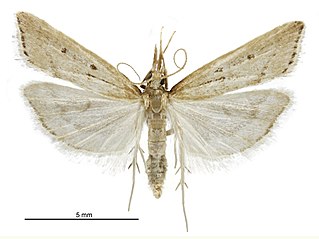
Antiscopa elaphra is a moth in the family Crambidae. It is endemic to New Zealand and has been observed in both the North and South Islands. Adults of this species are on the wing from August until March and are attracted to light. In 2020 this species had its DNA barcode sequenced.

Erechthias acrodina is a species of moth of the family Tineidae. This species was first described by Edward Meyrick. It is endemic to New Zealand and is found in the North, South and the Chatham Islands. This species inhabits native forest often near Phormium species and have also been observed on dead Leptospermum scrub. Larvae has been reared from decaying Phormium leaves. Adults are on the wing from October to February.

Erechthias charadrota is a species of moth in the family Tineidae. It was first described by Edward Meyrick in 1880. This species is endemic to New Zealand and is found on both the North and South Islands. It inhabits native forest and the larvae likely feed on either deceased plant detritus or tough leaves of plants such as palms or flax. Adults are on the wing commonly from October to February and it is likely this species has two broods per year. Adults have been trapped via a blacklight.

Erechthias chasmatias is a species of moth in the family Tineidae. It was first described by Edward Meyrick in 1880. This species is endemic to New Zealand and is found in the North Island. This species inhabits native bush. Adults are on the wing from October to April and have been collected by beating small trees and foliage.

Zapyrastra calliphana is a species of moth of the family Momphidae. It was first described by Edward Meyrick in 1889. It is found throughout New Zealand including at the Manawatāwhi / Three Kings Islands as well as at the Norfolk Islands. The preferred habitat of this species are native forest clearings, shrubland or coastal habitat such as scrub or dunes. The larvae of this species are leaf miners and are hosted by Muehlenbeckia species. There are likely several generations during the New Zealand summer and one generation overwinters as pupae. This species is a day flying moth and adults can be observed on the wing from October to March.
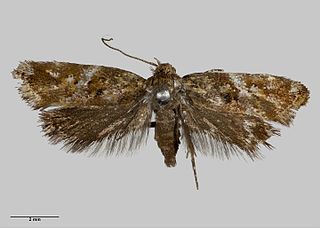
Tingena eumenopa is a species of moth in the family Oecophoridae. It is endemic to New Zealand and found in the North and South Islands. The adults have been found amongst tree ferns and are on the wing in December.

Tingena hemimochla is a species of moth in the family Oecophoridae. It is endemic to New Zealand and has been observed in the North Island. Adults of this species are on the wing from December until March.
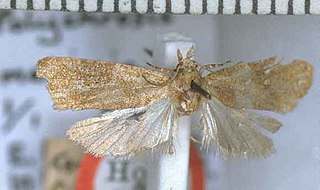
Polychrosis meliscia is a species of moth of the family Tortricidae. It is found in New Zealand at the Kermadec Islands.
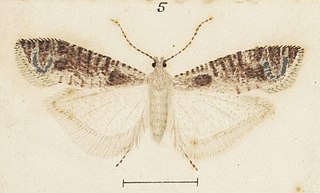
Holocola dolopaea is a species of moth in the family Tortricidae. It was first described in 1905 by Edward Meyrick. The species is endemic to New Zealand and has been observed in Whangārei, Hawkes Bay, Wellington and Christchurch. This species inhabits native forest or scrub glades. Adults are on the wing from September to December and are attracted to black light. This species is regarded as being rare.
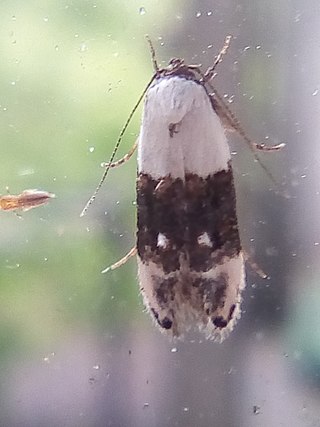
Trachypepla amphileuca is a species of moth in the family Oecophoridae. It is endemic to New Zealand and has been observed in the North Island. This species inhabits native forest. Adults are on the wing from October to January and are attracted to light. The wing pattern of T. amphileuca is said to imitate the appearance of bird droppings.
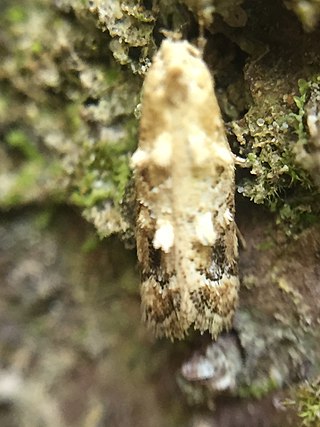
Trachypepla aspidephora is a species of moth in the family Oecophoridae. It is endemic to New Zealand and has been observed in the North and South Islands. Adults are on the wing from November to March and are attracted to light. The moths can be found resting on tree trunks where their colouration imitates lichens.

Atomotricha oeconoma is a moth in the family Oecophoridae first described by Edward Meyrick in 1914. It is endemic to New Zealand and has been observed at Mount Taranaki, Wellington and in Dunedin. The adults emerge in June. The female adult is semi-apterous and is incapable of flight.
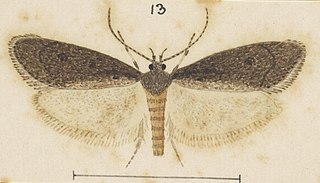
Atomotricha ommatias is a moth in the family Oecophoridae first described by Edward Meyrick in 1883. It is endemic to New Zealand and has been observed in the South Island. This species inhabits shrubland. The adults are out in the spring months of August and September and are attracted to sugar traps. The female of the species os brachypterous and is incapable of flight. Both the male and female of the species have been observed resting on fences during cold nights. The female, if touched, will hop two or three inches.
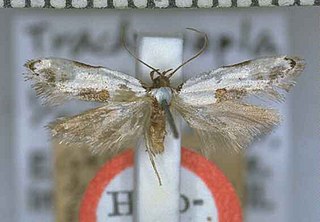
Trachypepla hieropis is a moth of the family Oecophoridae first described by Edward Meyrick in 1892. It is endemic to New Zealand and has been collected in both the North and South Islands. This species inhabits native forest and the larvae feed on leaf litter. Adults are on the wing in December and are attracted to light.

Trachypepla protochlora is a moth of the family Oecophoridae first described by Edward Meyrick in 1883. It is endemic to New Zealand and is found in both the North and South Islands. The preferred habitat of this species is native forest and adults are on the wing from October until February. Adults can be variable in their green shaded colour as well as in the intensity of markings on their forewings. The greenish ground colouration of this moth ensures they are well camouflaged when at rest on green mosses and lichens.
























